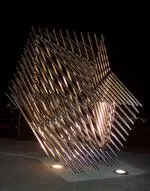Hautaha by Filip Tohi
Written by

Onehunga Public Artwork
FilipeTohi has lived in New Plymouth for 22 years where he has made a name as a stone carver. For many years now Filipe has studied the Tongan traditional art of lalava, or decorative rope lashing, observing closely the work of the last known master of lalava, the late Tamale of Niutoua. Onehunga Public Artwork
FilipeTohi has lived in New Plymouth for 22 years where he has made a name as a stone carver. For many years now Filipe has studied the Tongan traditional art of lalava, or decorative rope lashing, observing closely the work of the last known master of lalava, the late Tamale of Niutoua.He has also studied kupesi motifs, which are used by Tongan women to decorate their ngatu, or tapa cloth. From these studies Filipe has documented a collection of characters, enabling him to read the messages that historically were lashed onto the interior of buildings, and other projects.
Dr Karen Stevenson, senior lecturer at Canterbury University writes " Filipe Tohi has spent the last decade studying the complexity of Tongan lashings, design patterns, and creating in essence a cultural language. Tohi is not trying to revive a lost knowledge, but is trying to understand the enormity of cultural knowledge entwined in this endeavour. For Tohi the answers to the universe can be found in the patterns of lalava; they are, as he says, the metaphor of DNA in modern times."
Filipe has captured the interest of the arts community internationally by interpreting these traditional art forms into stunning contemporary art works.
Apart from NZ he has exhibited in Japan, France, New York, Australia and New Caledonia and was an invited sculptor at the 5th biennale d'art Contemporain, France. In 2000 he was the Macmillan Brown Artist in residence at Ilam School of Fine Art in Christchurch.
Onehunga project
Filipe has constructed a three metre tall sculpture of stacked steel tube titled "Hautaha" (coming together) based on traditional Tongan lalava lashing. He defines lalava as the intersection of two lines, there is always a male and a female line, and these lines become a metaphor for the ways of the world. He creates patterns that become symbols of human interaction.
"Hautaha" references the coming together of diverse groups from early Maori to colonising Europeans to migrating Pacific Islanders into the region. Filipe sees the form as female, embracing, welcoming and encompassing local residents and visitors to the community. The lashing pattern also references the rope work on the boats visiting the port, from the early Pacific peoples to the sailing ships and modern freight ships today.
Filipe Tohi is represented by Deborah White of Whitespace
www.whitespace.co.nz